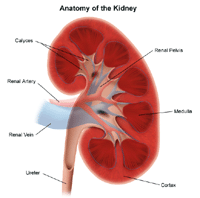Ureteropelvic Junction Obstruction
The ureter is a long thin tubular structure 10-12 inches long which carries urine produced in the kidney to the bladder. The urine is transported by a process called peristalsis. The ureter actively propels urine from the kidney down into the bladder.
Ureteropelvic junction obstruction is a condition where blockage occurs at the junction where the ureter attaches to the kidney. This results in decreased flow of urine down the ureter and an increase of fluid pressure inside the kidney. Increased pressure inside the kidney can over time cause deterioration of kidney function. The obstruction can be either congenital (the patient is born with it) or develop over time secondary to trauma or change in body shape with age. The blockage can be due to scar tissue, kinking, a blood vessel or rarely tumor.
Signs and Symptoms
Ureteral obstruction can cause flank pain on the effected side. The pain may be intermittent and some patients notice increased pain when drinking alcohol, coffee or increased fluids. The pain can sometimes be in the front of the abdomen and can radiate down to the groin. In some instances, the condition is detected accidently on x-rays or ultrasound during evaluation for unrelated problems. When infection occurs in association with obstruction, patients can become quite ill and have high fevers. This condition may require hospitalization, emergency drainage of the urine and treatment with intravenous antibiotics.
Treatments
The traditional treatment for ureteropelvic junction obstruction has been open surgery to cut out the area of scarring and re-connect the ureter to the kidney. Over the past several years, newer less invasive treatment options have been developed.
Endopyelotomy is a procedure through which a telescope or balloon with an electric wire on it is passed to the level of the kidney. The scar tissue is then cut open from the inside. These procedures can be done in a short period of time as an outpatient with minimal anesthetic and with a much shorter recuperation than with open surgery. Patients will have to keep a temporary internal tube (stent) for four to six weeks. The radiographic success rate with these procedures are 15%-20% lower than what is obtained with open surgery. Moreover, 40% of patients may have significant persistent pain following procedure.
Laparoscopic Pyeloplasty was developed in order to give the same high success rate obtained with open pyeloplasty while decreasing the morbidity. The internal procedure is performed in the same manner as the open surgery without the need for a large incision. Postoperative pain is less, recuperation is significantly quicker and scarring is minimal when compared with open surgery. The procedure requires a general anesthetic and hospitalization (usually 2 nights). An internal stent is also needed for four weeks. Success with this procedure is the same as open surgery (>95%).
Ureteropelvic Junction Obstruction in Children
Ureteropelvic junction (UPJ) obstruction is a blockage in the area that connects the renal pelvis (part of the kidney) to one of the tubes (ureters) that move urine to the bladder. It generally occurs when a baby is still growing in the womb. This is called a congenital condition (present from birth).
Most of the time, the blockage is caused when the connection between the ureter and the renal pelvis narrows. This causes urine to build up, damaging the kidney.
The condition can also be caused when a blood vessel is located in the wrong position over the ureter.
UPJ obstruction is the most frequently diagnosed cause of urinary obstruction in children. It is now commonly diagnosed during prenatal ultrasound studies. In some cases, the condition isn't seen until after birth.
Symptoms
There may not be any symptoms. When symptoms occur, they may include:
-
Back or flank pain
-
Bloody urine (hematuria)
-
Lump in the abdomen (abdominal mass)
-
Kidney infection
-
Poor growth in infants (failure to thrive)
-
Urinary tract infection, usually with fever
-
Vomiting
Diagnosis
An ultrasound during pregnancy may show kidney problems in the unborn baby. Tests after birth may include:
-
BUN
-
Creatinine clearance
-
CT scan
-
Electrolytes
-
IVP
-
Nuclear scan of kidneys
-
Voiding cystourethrogram
Treatment
Most cases of UPJ obstruction actually do not require surgery and resolve on their own. However, if patients exhibit pain, recurrent infections, evidence of worsening function or increasing swelling, they may require a surgery called a pyeloplasty to prevent kidney injury and correct the blockage. While this surgery was traditionally performed using an open incision underneath the ribcage, the standard of care in most children older than two years is to perform this surgery laparoscopically using a surgical robot. Robotic surgery can be performed through three small keyhole incisions in the abdomen and is associated with a shorter hospitalization, decreased pain following surgery, quicker recovery and return to normal activities, as well as improved scar appearance when compared with traditional open surgery — and has a 97 percent success rate.





